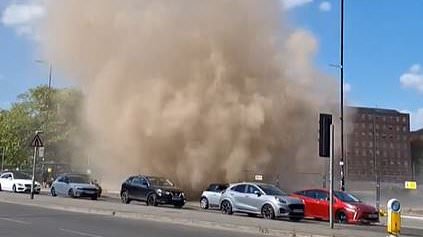This is the terrifying moment a ‘dust devil’ tornado rips through a road packed with cars in a major UK city.
Bystanders gawked at the 30-metre high swirling column of dust as it hurdled its way down Great Ancoats street in Manchester on Saturday.
The towering cloud of dust briefly brought traffic to a standstill with its tornado-like appearance as it enveloped a large tree.
‘What the…? What the hell? There is a tornado in the middle of Manchester… that’s crazy,’ the bewildered onlooker exclaimed.
But not everyone was amazed by the swirling dust, as violinist, Adam Riding, 30, confessed he ‘froze’ when he saw the dust billowing upwards.
It was this dark cloud and at first I thought it was an explosion but I didn’t really hear any noise. I froze,’ he told Manchester Evening News.
‘I didn’t know what to do and as it got higher and higher I got my phone out and started videoing it. It was probably over within a minute.’
Elsewhere Peter David McHugh was briefly left in darkness when the dust devil cast a shadow over his building.
‘I was inside and it was quite a sunny day and suddenly I was cast in darkness,’ the web developer revealed.
‘I looked out and there’s there’s this towering cloud of dust. I jumped up and thought “it’s a tornado or something”.
‘It was really interesting. I’ve lived here eight years and I’ve never seen that. It was pretty wild.’
Despite the amazement of those around, the ‘tornado’ quickly dissipated after a few seconds – as it was actually no windstorm but in fact a dust devil.
A Met Office meteorologist later deciphered the twirling cloud was a dust bunny due to the sunny weather, elaborating that tornadoes require heavy rain or a thunder storm.
‘A dust devil forms due to irregularities caused by temperature contrasts on different surfaces around which then causes rotation of the air and, when there’s dust and debris, you can get these columns of air,’ they said.
Dust devils were also much smaller than tornadoes which can be around half-a-mile wide, he added.
The Met Office described a dust devil, as ‘an upward spiralling, dust filled vortex of air that may vary in height from a few feet to over 1,000’.
‘They are usually several metres in diameter at the base, then narrowing for a short distance before expanding again.’
They also explained that they mainly occur in desert and semi-arid areas, where the ground is dry and high surface temperatures produce strong updrafts, with its initial rotation being sparked by ‘irregularities’ on the surface.
‘Unlike tornadoes, dust devils grow upwards from the ground, rather than down from clouds,’ the forecaster elaborated.
‘In the stronger dust devils, a cumulous cloud can be seen at the top of the rising column of warm air. They only last a few minutes because cool air is sucked into the base of the rising vortex, cooling the ground and cutting off its heat supply.’
